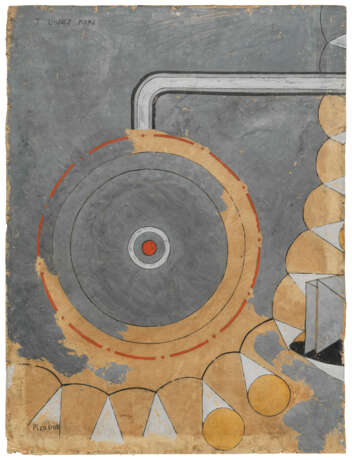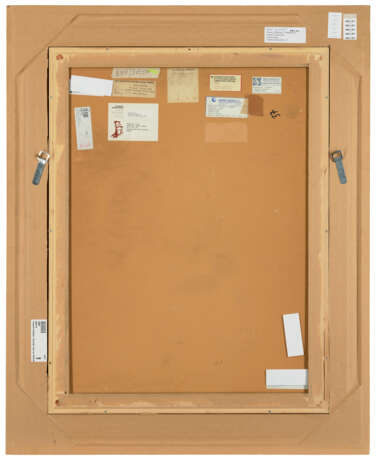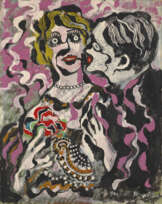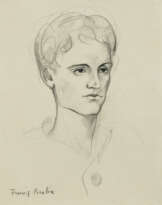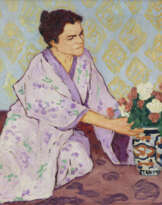ID 929412
Лот 4 | Francis Picabia (1879-1953)
Оценочная стоимость
€ 1 000 000 – 1 500 000
Tournez rare
porte la signature 'Picabia' (en bas à gauche) et porte l'inscription 'TOURNEZ RARE' (en haut à gauche)
gouache, encre et graphite sur carton
83.2 x 63 cm.
Exécuté vers 1919
bears the signature 'Picabia' (lower left) and bears the inscription 'TOURNEZ RARE' (upper left)
gouache, ink and pencil on cardboard
32 3/4 x 24 3/4 in.
Executed circa 1919
Provenance
Marcel Duchamp, Paris (acquis auprès de l'artiste); vente, Me Bellier, Paris, 8 mars 1926, lot 22 (verso de 'Serpentins').
André Breton, Paris (acquis au cours de cette vente).
Simone Collinet (Galerie Artiste et Artisan/Galerie Furstenberg), Paris (acquis auprès de celui-ci en 1949).
Malitte et Roberto Matta, Paris (acquis auprès de celle-ci en 1959); vente, Sotheby's, Paris, 9 décembre 2009, lot 34.
Acquis au cours de cette vente par le propriétaire actuel.
Literature
M. L. Borràs, Picabia, Paris, 1985, p. 512, no. 229 (illustré, p. 226, fig. 361; daté '1918-19').
W. A. Camfield, B. Calté, C. Clements, A. Pierre et A. Verdier, Francis Picabia, Catalogue raisonné, 1915-1927, Bruxelles, 2016, vol. II, p. 269, no. 619 (illustré en couleurs).
Exhibited
Paris, Grand Palais des Champs-Élysées, Catalogue des ouvrages de peinture, sculpture, dessin, gravure, architecture et art de´coratif, novembre-décembre 1919, no. 1535 (verso de 'Serpentins').
Paris, Galerie René Drouin, 50 ans de plaisirs, mars 1949, no. 16 (verso de 'Serpentins'; daté '1916').
Paris, Galerie Artiste et Artisan, Quelques œuvres de Picabia, Époque Dada, 1915-1952, novembre-décembre 1951 (verso de 'Serpentins'; daté '1917-18').
Paris, Galerie Furstenberg, Exposition Picabia, juin-juillet 1956, no. 13 (verso de 'Serpentins').
Saint-Étienne, Musée d'art et d'industrie, Art Abstrait, Les Premie'res Ge´ne´rations, 1910-1939, 1957, no. 48 (verso de 'Serpentins').
Londres, The Matthiesen Gallery, Francis Picabia, octobre-novembre 1959, no. 21.
Berne, Kunsthalle, Francis Picabia, Werke von 1909-1924, juillet-septembre 1962, no. 24 (verso de 'Serpentins'; daté '1917-18').
Paris, Galeries Nationales du Grand Palais, Francis Picabia, janvier-mars 1976, p. 185, no. 58 (illustré, p. 78; daté '1915-17').
Nîmes, Musée des Beaux-Arts, Francis Picabia, juillet-septembre 1986, p. 158, no. 30 (illustré, p. 48).
Valence, Instituto Valenciano de Arte Moderno, Centre Julio Gonzàlez et Barcelone, Fundació Antoni Tàpies, Francis Picabia, Ma´quinas y Espan~olas, octobre 1995-mars 1996 (hors catalogue).
Special notice
Artist's Resale Right ("droit de Suite").
If the Artist's Resale Right Regulations 2006 apply to this lot, the buyer also agrees to pay us an amount equal to the resale royalty provided for in those Regulations, and we undertake to the buyer to pay such amount to the artist's collection agent.
ƒ: In addition to the regular Buyer’s premium, a commission of 5.5%
inclusive of VAT of the hammer price will be charged to the buyer.
It will be refunded to the Buyer upon proof of export of the lot
outside the European Union within the legal time limit.
(Please refer to section VAT refunds)
Post lot text
« La machine est devenue plus qu’un simple appendice à la vie. Elle fait réellement partie de la vie humaine… peut-être en est-elle l’âme ».
Francis Picabia
Cette œuvre au destin hors du commun, était à l’origine au verso d’une autre peinture Serpentins (1919), aujourd’hui conservée au Musée d’Art Moderne de la Ville de Paris. Elle fit partie de collections prestigieuses et notamment de celle de Marcel Duchamp. Mise en vente par ce dernier en 1926, elle est achetée par André Breton. L’œuvre rejoint ensuite la collection de Madame Simone Collinet, la première épouse d’André Breton, puis elle est acquise en 1962 par Roberto Matta, l’artiste et ami de Picabia.
Véritablement passionné par l’automobile et grand amoureux des belles cylindrées, Picabia connaît les rouages des moteurs. La représentation mécanique s’insère donc logiquement dans son iconographie, notamment lorsque l’artiste entra en contact avec la civilisation américaine et la ville de New-York qu’il visite à l’occasion de l’exposition de l’Armory Show de 1913. Marqué par l’omniprésence de la machine dans cette société en fin d’industrialisation, Picabia et son ami Marcel Duchamp, développent un langage mécanique à l’esprit industriel pour créer de véritables transmutations de l’être humain en mécanismes délirants, prémices des premiers Ready-mades. Les œuvres de Picabia de cette période (1915-1920) représentent des objets inanimés assumant des états humains.
C’est en 1915 à New-York, que Picabia réalise ses premières œuvres mécanomorphes dotés de titres surprenants et de légendes inopinées. La fille née sans mère (1915) est publiée dans le no. 4 de la luxueuse revue 291 d’Alfred Stieglitz. Picabia y publie également des portraits-objets de ses amis new-yorkais : le photographe Stieglitz y est représenté par un appareil photo cassé et le riche collectionneur Paul Haviland, transformé en lampe de bureau ultra-moderne ! Le plus emblématique de ces portraits est l’hommage posthume à Guillaume Apollinaire (1918). L’ami disparu de l’artiste y est représenté en carburateur annoté de citations issues des Epîtres d’Horace.
Si la machine n’est pas l’idéal de l’homme, Picabia développe un alphabet d’éléments mécaniques pour le représenter et illustrer ses comportements psychiques. Bien souvent au cœur de ces œuvres réside le paradigme de l’attirance et de l’interdépendance des sexes. Bientôt les attributs féminins, porte-jarretelles et corsets sont associés aux Delco, courroies d’allumage et bougies de moteurs dans les Machines célibataires symbolisant le jeu amoureux et la mécanique sexuelle. L’érotisme industriel sera au cœur de cette mise en vie de l’objet.
De retour à Paris en 1919, Picabia publie Pensées sans langage qui éblouit André Breton. Il s’essaye également aux côtés de Philippe Soupault à l’écriture automatique, l’expression « d’une poésie pure sans contrôle de la raison ». C’est aussi l’année du rapprochement avec Tristan Tzara qui contacte le peintre pour lui demander de collaborer à la revue et au mouvement d’avant-garde Dada. Lors d’une exposition organisée à la Kunsthause de Zurich, Tzara présente les dernières œuvres mécanomorphes de l’artiste. Gabrielle Picabia raconte la surprise des dadaïstes zurichois qui trouvèrent le peintre dans sa chambre d’hôtel occupé à démonter un réveil mécanique dont il prit les rouages, les trempa dans de l’encre avant de les presser sur une feuille de papier, œuvre qui fera la couverture de l’édition 4/5 de la revue Dada !
Cette même année, Picabia présente au Salon d’Automne quatre œuvres perturbantes à l’humour caustique dont l’Enfant Carburateur et Serpentins. Loin de la pate coloriste et orphique de l’œuvre d’avant-guerre de Picabia, les toiles se remplissent de tuyaux et blindages d’acier et de cuivre, véritables diagrammes d’ingénieurs. Ces œuvres embarrassent le jury du Salon qui, ne pouvant censurer le sociétaire qu’était Picabia, relèguent ses œuvres sous l’escalier… Picabia proteste dans une lettre adressée au Président du Salon qu’il accuse « de sacrifier les artistes vraiment modernes pour plaire aux imbéciles ».
Car cette démarche va bien au delà de la provocation et de la simple rupture esthétique de prime abord. Le couple machine-spiritualisée/homme-mécanique repose plus fondamentalement sur le dualisme corps/âme que Freud place au cœur de l’animisme. Conférer à la machine une âme ou un esprit est comparable à une forme d’animisme qui partant du règne de la nature anime et donne vie au règne mécanique.
La présente œuvre est un merveilleux exemple des préoccupations de l’artiste à cette époque et de sa recherche sur l’art-idée et la poésie-idée. Picabia poursuit sa quête artistique animée par l’émergence des concepts d’automatisme, d’inconscient et de hasard. Comme le dira Aragon, le peintre-poète utilise « les objets comme des mots ». Gabrielle Buffet ajoute que l’artiste « copie les épures d’ingénieurs avec un esprit littéraire et symbolique »… Picabia compose et connecte des objets à l’intérieur d’une sorte de « phrase graphique » où la métaphore est largement exploitée. Picabia affirme vouloir travailler jusqu'à ce qu'il atteigne « le sommet du symbolisme mécanique. »
Comme souvent chez Picabia les significations sont doubles comme l’indique le titre complexe de l’œuvre Tournez rare ou Sirènes. La cible centrale de la composition illustre vraisemblablement l’élément féminin centré autour d’un point rouge et se déclinant en cercles liminaires des zones d’alternances chromatiques. L’opposition des couleurs (gris/jaune orangé) renforce le caractère binaire de la composition. La zone de couleur chaude accueille une mécanique de rouages, symbole d’action et de production ou peut-être de la fertilité féminine ? Dans le haut du tableau, un tuyau symbolique inonde la composition d’un fluide gris, une autre métaphore de la virilité ? A l’image de la sirène, créature légendaire mi-femme mi poisson, cette œuvre réunit les impossibles, les oppositions et les couleurs antinomiques dans le mouvement. Le feu de la zone inférieure se diffusant dans la masse grise ou le fluide sombre se diluant dans la couleur vive, l’interaction entre les contraires est constitutive de l’équilibre dans le mouvement.
La présente œuvre est à rapprocher de Machine tournez vite (conservée à la National Gallery of Art de Washington DC) réalisée en 1916, qui figure deux rouages mécaniques dont les picots s’imbriquent au point de contact pour se séparer avant de se retrouver inexorablement au rythme de la périodicité de l’engrenage. Ces deux œuvres soulignent à la fois le principe de complémentarité et la fatalité des relations entre les êtres humains, destinés à se rapprocher, se mélanger et à se séparer, inévitablement.
Picabia aurait sans doute détesté qu’on enferme ses œuvres dans une explication rationnelle ou une pensée esthétique définie. L’artiste rejoint ainsi Baudelaire qui décriait « un système est une espèce de damnation qui vous pousse à une abjuration perpétuelle ». Avec ce nouveau langage mécanomorphe, Picabia échappe à l’antinomie scolaire et ennuyeuse de la représentation et de la non-représentation. Son talent réside dans son immense capacité d’invention du moderne et de l’étrange comme « peut l’être la vie quotidienne ». La source du mystère est trop frénétique et trop impulsive pour être dévoilée, décortiquée et arraisonnée à force de comparaisons ou d’efforts laborieux de compréhension. L’œuvre mécanique de Picabia révèle un besoin persistant du dépassement servi par une immense capacité imaginative. Picabia, maître de « l’esthétique de la surprise » est l’auteur de la transcription du réel en une langue inconnue et pure, qui semble poser ici, comme dans chaque œuvre, une hypothèse nouvelle.
" The machine has become more than a mere appendage to life. It is truly part of human life... perhaps it is its soul."
Francis Picabia
This work, with its exceptional destiny, was originally on the back of another painting, Serpentins (1919), now held in the Musée d'Art Moderne de la Ville de Paris. It was part of prestigious collections, notably that of Marcel Duchamp. Put up for sale by Duchamp in 1926, it was purchased by André Breton. The work then joined the collection of Madame Simone Collinet, Breton's first wife, before being acquired in 1962 by Roberto Matta, the artist and friend of Picabia.
Truly passionate about cars and a great lover of beautiful engines, Picabia understands the inner workings of motors. Mechanical representation became part of his iconography when he encountered American civilization and the city of New York during the Armory Show exhibition of 1913. Impacted by the omnipresence of machines in this industrializing society, Picabia and his friend Marcel Duchamp developed a mechanical language with an industrial spirit to create real transmutations of humans into delirious mechanisms, precursors of the first Ready-mades. Picabia's works from this period (1915-1920) represent inanimate objects assuming human forms.
In 1915 in New York, Picabia created his first mechanomorphic works with surprising titles and unexpected captions. The Girl Born Without a Mother (1915) was published in issue No. 4 of Alfred Stieglitz's luxurious magazine "291." Picabia also published portraits-objects of his New York friends: photographer Stieglitz is represented by a broken camera and wealthy collector Paul Haviland is transformed into an ultra-modern desk lamp! The most iconic of these portraits is the posthumous tribute to Guillaume Apollinaire (1918). The artist's departed friend is represented as a carburetor annotated with quotes from Horace's Epistles.
If the machine is not the ideal of man, Picabia develops an alphabet of mechanical elements to represent it and illustrate its psychic behavior. Often at the heart of these works lies the paradigm of attraction and interdependence of the sexes.Soon, feminine attributes such as garter belts and corsets are associated with Delco, ignition belts, and motor spark plugs in the "Bachelor Machines" symbolizing the game of love and sexual mechanics. Industrial eroticism is at the heart of this objectification of the machine.
Back in Paris in 1919, Picabia published Pensées sans langage, which dazzled André Breton. He also tried alongside Philippe Soupault to write automatic poetry, the expression of "pure poetry without control of reason." This was also the year of his approach to Tristan Tzara, who contacted the painter to ask him to collaborate on the Dada avant-garde magazine and movement. During an exhibition organized at the Kunsthause in Zurich, Tzara presented the artist's latest mechanomorphic works. Gabrielle Picabia recounts the surprise of the Zurich Dadaists who found the painter in his hotel room, busy dismantling a mechanical alarm clock, taking its gears, dipping them in ink before pressing them onto a sheet of paper, a work that would make the cover of edition 4/5 of the Dada magazine!
That same year, Picabia presented four disturbing works with caustic humor at the Salon d'Automne, including Enfant Carburateur and Serpentines. Far from the colorful and Orphic style of Picabia's pre-war work, the canvases are filled with pipes and steel and copper armor, true engineer's diagrams. These works inflamed the Salon jury, who, unable to censor Picabia as a member, relegated his works under the stairs... Picabia protested in a letter to the President of the Salon, whom he accused of "sacrificing truly modern artists to please fools."
For Picabia, this approach goes far beyond provocation and simple aesthetic rupture at first glance. The machine-spiritualized/human-mechanical couple rests more fundamentally on the body/soul dualism that Freud places at the heart of animism. Giving a soul or spirit to a machine is comparable to a form of animism that, starting from the realm of nature, animates and gives life to the mechanical realm.
The work presented here is a wonderful example of the artist's concerns at that time and of his research on art-idea and poetry-idea. Picabia continues his artistic quest driven by the emergence of concepts of automatism, the unconscious, and chance. As Aragon said, the painter-poet uses "objects as words". Gabrielle Buffet added that the artist "copies engineers' blueprints with a literary and symbolic spirit"... Picabia composes and connects objects within a sort of "graphic sentence" where metaphor is widely exploited. Picabia claimed that he wanted to work until he reached "the peak of mechanical symbolism."
As often with Picabia, the meanings are dual as indicated by the complex title of the work Tournez rare ou Sirènes. The central target of the composition likely illustrates the feminine element centered around a red point and declining into circles of chromatic alternations. The opposition of colors (gray/orange-yellow) reinforces the binary nature of the composition. The warm color area accommodates a mechanical system of gears, a symbol of action and production or perhaps of female fertility? In the upper part of the painting, a symbolic pipe floods the composition with a gray fluid, another metaphor for virility? Like the mermaid, a legendary creature half-woman half-fish, this work brings together impossibilities, oppositions, and antinomic colors in motion. The fire in the lower zone diffusing into the gray mass or the dark fluid diluting into the bright color, the interaction between opposites is constitutive of balance in motion.
The present work can be compared to Machine tournez vite (held at the National Gallery of Art in Washington DC) produced in 1916, which depicts two mechanical gears whose pins interlock at the point of contact to separate before coming together again inexorably at the rhythm of the gear. These two works underline both the principle of complementarity and the inevitability of relationships between human beings, destined to come closer, mix and separate, inevitably.
Picabia would have undoubtedly hated to have his works confined to a rational explanation or a defined aesthetic thought. The artist thus joins Baudelaire, who criticized that "a system is a kind of damnation that pushes you towards perpetual renunciation". With this new mechanomorphic language, Picabia escapes the school-like and tedious antinomy of representation and non-representation. His talent lies in his immense capacity to invent the modern and the strange, as "everyday life can be". The source of the mystery is too frenetic and impulsive to be unveiled, dissected, and grasped by means of comparisons or laborious efforts of understanding. Picabia's mechanical work reveals a persistent need for transcendence served by an immense imaginative capacity. Picabia, master of the "aesthetics of surprise", is the author of the transcription of reality into an unknown and pure language, which seems to pose here, as in every work, a new hypothesis.
| Автор: | Франсис Пикабиа (1879 - 1953) |
|---|---|
| Техника исполнения: | Гуашь, Масло, Расписанный |
| Материал: | Акриловое стекло, Пластик |
| Категория аукционного дома: | Картины |
| Автор: | Франсис Пикабиа (1879 - 1953) |
|---|---|
| Техника исполнения: | Гуашь, Масло, Расписанный |
| Материал: | Акриловое стекло, Пластик |
| Категория аукционного дома: | Картины |
| Адрес торгов |
CHRISTIE'S 9 Avenue Matignon 75008 Paris Франция | ||||||||||||||
|---|---|---|---|---|---|---|---|---|---|---|---|---|---|---|---|
| Предосмотр |
| ||||||||||||||
| Телефон | +33 (0)1 40 76 85 85 | ||||||||||||||
| Факс | +33 (0)1 40 76 85 86 | ||||||||||||||
| Условия использования | Условия использования | ||||||||||||||
| Транспортировка |
Почтовая служба Курьерская служба Самовывоз | ||||||||||||||
| Способы оплаты |
Банковский перевод | ||||||||||||||
| Часы работы | Часы работы
|

